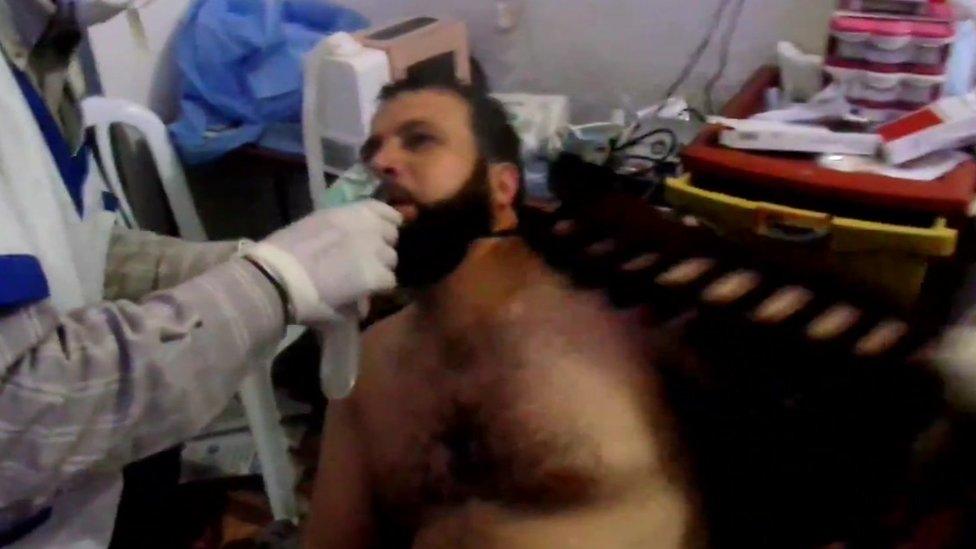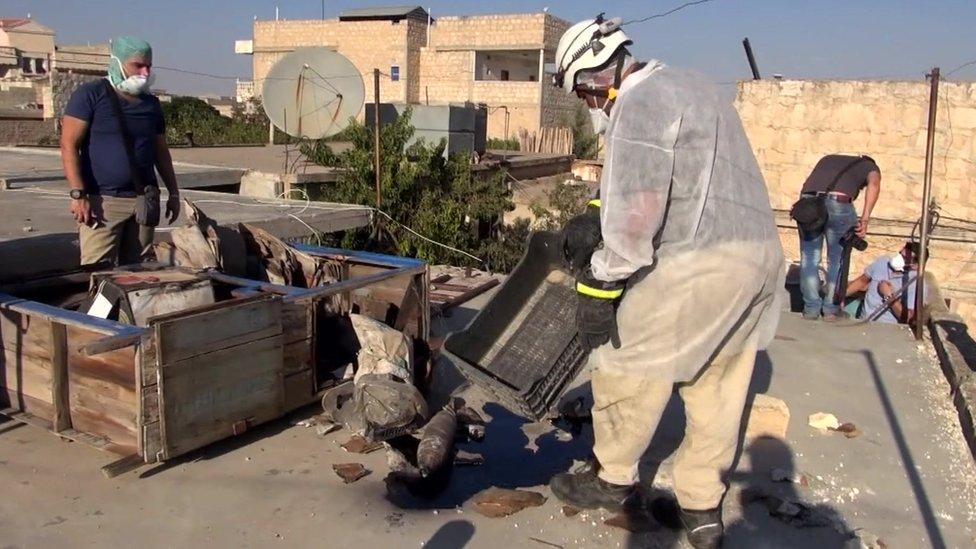Syria civilians still under chemical attack
- Published
Harrowing footage showed the aftermath of an alleged chlorine gas attack by Syrian government forces
The video is painfully difficult to watch. The pale, wet, listless bodies of young children are carried into a hospital as doctors frantically try to save lives. Men choke and vomit and cry out and a grandmother lies peacefully on a gurney. She is dead.
Five others died in the same attack on Sarmin, about 50 km (30 miles) southwest of Aleppo, in March this year - including three small children. None of them had a scar on their bodies.
For the children of Syria, it is not the high seas they must fear but death on dry land.
The footage was apparently taken in the aftermath of a chemical attack.
When it was shown to the UN Security Council it reportedly moved delegates to tears, and is just one of more than 60 incidents in which toxic agents are alleged to have been deployed.
Now, a leading chemical weapons expert has told the BBC there is "very strong and compelling evidence" that mustard gas has been used in a recent attack, blamed on Islamic State (IS) militants.

Civilians are supposed to be protected under the Chemical Weapons Convention
Last month the UN voted to set up an investigation to find out which individuals, groups or governments are involved in the use of chemicals as weapons in Syria.
The Syrian government has been repeatedly accused of perpetrating many of these attacks, something it vehemently denies.
But when Sarmin was attacked, witnesses say they heard a helicopter overhead and only government forces have helicopters in Syria.
Then people say they heard a roaring sound, like thunder but there was no explosion, just casualties.
Two years ago the UN voted unanimously in favour of the destruction of Syria's chemical weapons. It was perhaps the only threat that civilians were supposed to be protected from.
But there have been growing allegations that chemicals, in particular chlorine gas, have been used, mostly against civilian populations in dozens of attacks.
The Organisation for the Prohibition of Chemical Weapons (OPCW) looked at three of these alleged attacks and reported to the UN they have "a high degree of confidence that chlorine has been used repeatedly and systematically as a weapon" in Syria.

Syria's government has faced several accusations it used chlorine gas
Chlorine was first used as a weapon in the trenches of World War One. Denser than air, it was used to flush soldiers out of the trenches.
Many victims in Syria appear to exhibit symptoms consistent with such toxic agents but proving it is hard, not least because investigators cannot get the rapid access to sites that they would need to conduct verifiable tests.
The Syrian government has told us it has never used chemical weapons. It blames what it calls "terrorists" instead.
Rebel forces and more recently IS also stand charged. The militants have repeatedly attacked the town of Marea in northern Syria. But two recent strikes are feared to have involved chemicals.
I understand samples have been passed to the British government for testing.
This time the symptoms were different, with people exhibiting huge painful blisters and burns.

The British government is testing samples to determine if IS used mustard gas, the BBC understands
The fear is that IS has acquired and now used mustard gas.
'Chemical agent' traced in IS fire, says US general
Tarek Najjar, the director of the hospital in Marea where casualties were admitted, says he suspected mustard gas after seeing the symptoms. They included "suffocation, blisters, watery eyes and runny nose," he says. "We've never seen any injuries like this before. It's the first time to see such symptoms and casualties."
Jerry Smith, the OPCW's former head of operations in Syria, says "there's very strong and compelling evidence that this was a vesicant, a mustard agent that was used on this attack".

"Even if it wasn't actual mustard that was used, Any chemical that uses its damaging properties and used by an attacker is breaking the Chemical Weapons Convention and the Geneva protocol of 1925 and constitutes a war crime."
This week we have seen yet more people gathering on the Syrian side of the border, getting ready to leave and join the tens of thousands already heading for Europe - families who have endured four years of fear, who have been shot at, shelled and gassed.
With no sign of respite or relief it is unsurprising that so many Syrians are now on the move.

Analysis: Frank Gardner, BBC Security Correspondent
Syria was supposed to be rid of all chemical weapons, following a Russian-brokered UN deal two years ago. But it is clear this is not the case.
So where are these stocks coming from?
Chlorine, as a chemical, is not banned - it is readily available.
And according to chemical weapons expert Hamish de Bretton-Gordon, IS could have obtained mustard gas from three possible sources: from a large Iraqi facility they overran last year, from stocks the Syrian government failed to declare to the UN, and, most worryingly, from their own production line.
He said all the necessary precursor chemicals were present in Syria and that Islamic State had the expertise to turn it into a weapon.
